


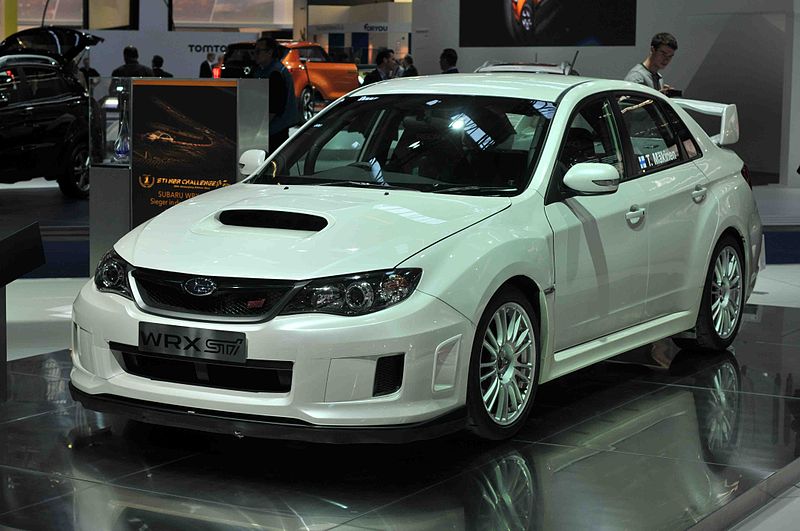



The new Impreza WRX was released in 2007 for the 2008 model year. The engine used is still the EJ255. The US-spec WRX reverts back to a 2-piston/1-piston sliding calipers (dropping the 4-piston/2-piston fixed caliper setup), but have grown to 11.6-inch (295 mm) in the front and 11.3-inch (287 mm) in the rear, the same as the BL5-chassis US-spec Legacy 2.5i.
In response to criticism that the new WRX's suspension was too soft, and needing to keep on par with rival car companies new releases, some changes were made in 2008 for the 2009 model year. The EJ255 received a boost of 41 horsepower (31 kW) and 18 lb·ft (24 N·m) of torque, bringing the total output to 265 bhp (198 kW; 269 PS) and 244 lb·ft (331 N·m) of torque by swapping the previous TD04 turbo to an IHI VF52. This WRX is capable of 0–60 mph in 4.7 seconds and a standing 1/4 mile in 13.5 seconds at 102 mph (164 km/h).[11] In addition, the 2009 model received stiffer suspension parts from the STi model, an aerodynamic package and Dunlop SP Sport 01 summer performance tires as standard equipment. Cosmetic changes included an updated mesh grill with WRX badge and darker wheels. The WRX is also only available with 5-speed manual transmission. In the USA, the 4-speed automatic is only available on a new Impreza model called the 2.5 GT, which features the same 2.5L 4-cylinder 224 hp (167 kW; 227 PS) Subaru Boxer Turbo engine as in the 2008 WRX. While in Canada, the 265 hp (198 kW) engine was an option on WRX 265 models in 2009 and the 224 hp (167 kW) is discontinued in Canada for 2010.
In 2010 for year model 2011, the Impreza WRX got the widebody look in both sedan and hatchback, which are the same body shells as the STI, as well as the addition of quad muffler tips with diffuser which changes the look of the rear end. The new model gains 33 pounds over the previous 2010 WRX models. The wider body gives the 2011 WRX wider track dimensions. The new exterior design is being marketed to attract younger buyers. For the US market, the WRX is offered in the Base, Premium, and Limited trim levels. As of June 14, 2011, it is reported that the 2011 model year may be the rarest ever released due to the recent disasters in Japan. Subaru dealerships are no longer taking orders for the 2011 model year. An approximately 1.5-inch (38 mm) increase in front and rear track, firmer rear sub-frame bushings and wider 17-inch wheels and tires deliver improved grip in the 2010 WRX.
WRX STI
The 2008 STI has received a higher degree of parts to differentiate it from its Impreza WRX brethren. Unlike the WRX, the STI uses aluminum suspension components, and has different fenders that are 2.2 in (56 mm) wider. It adopted "Subaru Intelligent Chassis Design" and "Dynamic Chassis Control Concept". The turbo forces air through a larger top-mount-intercooler which has lost the red "STI" that was on previous generations. It is the first generation of this model with an automatic transmission which is able to import to outside Japan.
The STI features multi-mode electronic stability control with "normal", "traction", and "off" modes; Subaru Intelligent-Drive (SI-Drive) with 3 modes: intelligent, sport, and sport sharp; and multi-mode Driver's Controlled Centre Differential (DCCD). The DCCD enables driver to select the manual or auto: "auto", "auto+", and "auto-" mode in order to distribute the torque based on driving preference or conditions.
Subaru Impreza WRX STI (Japan)
The JDM version has a 2.0L 308 PS (227 kW; 304 bhp) EJ207 engine with a Twin scroll turbocharger, while other versions of the car have a 2.5L 300 PS (221 kW; 296 bhp) EJ257 engine with a single-scroll VF48 turbocharger.
The latest US model of the STI has 305 bhp (227 kW; 309 PS) and 290 ft·lbf (390 N·m). of torque and range in price from $35,640 to $39,440, depending on the options included. The 2008 Impreza STI has the model code GR, reflecting the different "wide body" 5-door Hatchback compared to the GH standard body 5-door Hatchback used for the 2008 Impreza WRX and non-turbo models. The new "wide body 5-door" chassis is 70.7 in (1,796 mm) wide compared to 68.5 in (1,740 mm) for the regular WRX 5-door chassis. Curb weight varies from 1,505 kg (3,318 lb) to 1,540 kg (3,395 lb) depending on the options.
In 2008, a Subaru WRX STI spec C was in the works for production. It had been spotted lapping the Nurburgring. It is expected to shed 70 kg (154 lb) in weight, have minor engine tweaks, have an updated aero kit, and bigger brakes.
A possible precursor to the WRX STI spec C had surfaced at the MotorSport Japan 2008 auto show, named the Subaru Takumi concept. The only visual cues to differentiate this car from the regular STI are a blacked-out rear spoiler, front lip spoiler, and 12-spoke wheels that are strikingly similar to the ones featured on the spec C test mule spotted around the Nurburgring. The upgraded parts included on the car are drivetrain and suspension modifications. There is no word on performance figures or power output. It was later confirmed by Autoblog that the Takumi concept was in fact just an unveiling of the 20th Anniversary Edition WRX STI and not the spec C. All 300 examples will be exclusive to the Japanese market.
2011 Subaru Impreza WRX STI A-Line
Subaru launched the Impreza WRX STI A-Line with a five speed semi-automatic gearbox on February 24, 2009. Available initially only in Japan and Singapore, the A-Line features include "Downshifting Blipping Control" and steering wheel-mounted paddles The engine and transmission in the A-Line are very similar to 2007–2009 Legacy 2.5 GT models. However, the A-line has less torque (35.7kgfm) and slower acceleration (0 to 100 km/h takes 6.1 seconds) compared to the manual STI version, although lighter (1,490 kg vs 1,505 kg). The A-Line is also offered in Hong Kong, and later in Indonesia with debut at the 2010 Indonesia International Motor Show in July 2010, and will be exported to Australia in 2011.[15]
On July 23, 2009, the Subaru Impreza WRX STI spec C was released in Japan. The 900 units limited edition WRX STI spec C has engine, suspension, and body parts improvement over the regular model. The ball bearing on the turbine axle had been modified to reduce friction, the ECU had been retuned for better response, and an intercooler water spray was fitted to prevent rise in the air temperature. The cross member, suspension and power steering were also improved for better handling and body rigidity. Aluminium hood, laminar window glasses, and lighter battery helped to reduce weight.
Subaru (UK) Limited introduced two new WRX STI models at the British Auto Show that have specific tuning by Prodrive. The first is WRX STI 330S, produces 330 PS (243 kW; 325 bhp) and has a 0–60 mph time of 4.4 seconds. The last of the two was the WRX STI 380S, which sports new wheels and an upgraded body kit and was expected to produce 380 PS (279 kW; 375 bhp). Subaru announced, on September 10, 2008, that the 380S variation would not be produced, due to homologation and specification difficulties. The regular 330S model is called WRX STI Type UK.
2010 Subaru Impreza WRX STI with optional BBS wheels
The Singaporean, Indonesian, and Australian (all RHD countries) markets received the 2.5 liter Euro-spec version instead of the J-spec version, producing 296 horsepower (221 kW) and 407 N·m (300 lb·ft) of torque.[16] Some of Impreza WRX STI's sold in Indonesia are the 2.0 liter JDM spec brought by the general importers before Subaru officially introduced the 2.5 liter model. In Australia the regular WRX STI is sold alongside the WRX STI spec.R which comes with BBS wheels and Recaro seats.
For 2010 model year, Subaru of America introduced the Impreza WRX STI Special Edition Similar to JDM WRX STI Spec C, this model came with stiffer suspension and thicker stabilizer bar for better handling. It also has 7 twin-spokes dark gray 18 inch alloy wheels. Inside, the limited-run Special Edition STI got manual air conditioner and 4-speaker stereo instead of automatic climate control and 10-speaker premium audio on the regular WRX STI.
2011 Subaru Impreza WRX STI 4 door (Europe)
In 2010 for the 2011 model year Impreza WRX STI was offered in the 4 door Sedan bodystyle once again after a three year absence from the STI line-up since the introduction of third generation model. The new WRX STI Sedan is built as "wide body" with flared fenders, front skirts, and rear valance, while the Hatchback model also comes with similar treatments. The most noticeable feature on the STI Sedan is a large rear wing, characteristic of the last generation Impreza STI Sedan. With the new front bumper, the 2011 Impreza WRX STI is more aggressive compared to 2008–2010 models. The 2.5 flat four turbocharged engine with 305 horsepower is carried over, while tweaks in suspension improve handling. The 2011 model year STI has stiffer springs, bigger anti roll bars, and new pillow ball bushings on the front lower arms, as well as wider standard tires . Also, US dealers are now requiring synthetic oil for 2011 models. It is officially claimed to do 0–60 mph in 4.9 seconds and the quarter mile 13.7 seconds. Officially called the Subaru WRX STI 4-door and Subaru WRX STI 5-door, US-market versions adds the Impreza model name.
Australia also received the 2011 model year WRX STI as 4 door Sedan and 5 door Hatch in the regular STI and luxury STI spec.R with manual and automatic transmissions offered.] Electric sunroof, Leather seats, Navigation system, and BBS wheels are standard on the STI spec.R, while Recaro seats are optional.
Available for the UK market only, the Cosworth Impreza STI CS400 was announced in late May 2010. Only 75 units built, the STI CS400 is powered by a 400 PS (294 kW; 395 hp) The Cosworth-tuned, turbocharged vehicle is one of the world's most accelerative hatchbacks. The renowned 2.5-litre turbocharged Boxer engine is transformed to produce 33% more power, drawing heavily on Cosworth's extensive Formula 1 experience. The engine, which drives all four wheels via a six-speed manual gearbox, boasts an impressive 400 PS and the new model reaches 62 mph in just 3.7 seconds, going on to cover a quarter mile (1/4) in 12.75 seconds at a terminal speed of 107 mph. Top speed is limited to 155 mph. 2.5 liter turbocharged engine has Cosworth engineered forged connecting rods, racing pistons, heavy duty cylinder head studs, multi-layered head gasket, and high pressure oil pump. The ECU had been remapped, and the new compressor design and wastegate actuator had been applied to the turbo. The exhaust system features larger capacity tubular manifold and bigger diameter downpipes. Clutch was also upgraded. The Cosworth Impreza STI CS400 can be distinguished from the regular STI from its upper mesh grille with piano black finish on the top frame, modified front bumper with "Cosworth" emblem on the lower mesh grille, and lip spoiler, 18 inch Pro-Race alloy wheels in Antrachite Gray, and trunk waist spoiler. To match its performance, the CS400 comes with Bilstein struts and Eibach springs for better quality ride, and better handling with less pitch and roll during cornering. Braking was updated by AP Racing's larger diameter ventilated front brakes with six-pot calipers. Inside, the CS400 has Recaro leather seats with "Cosworth" label, piano black center console panel, and "Cosworth"-badged floor mats
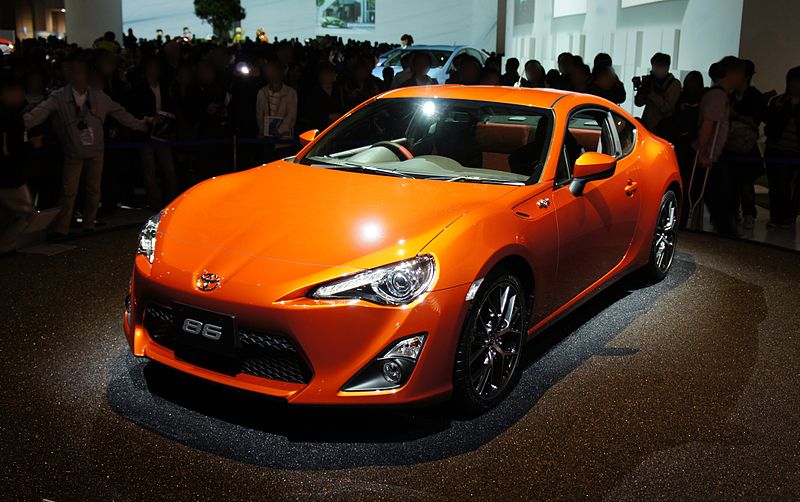

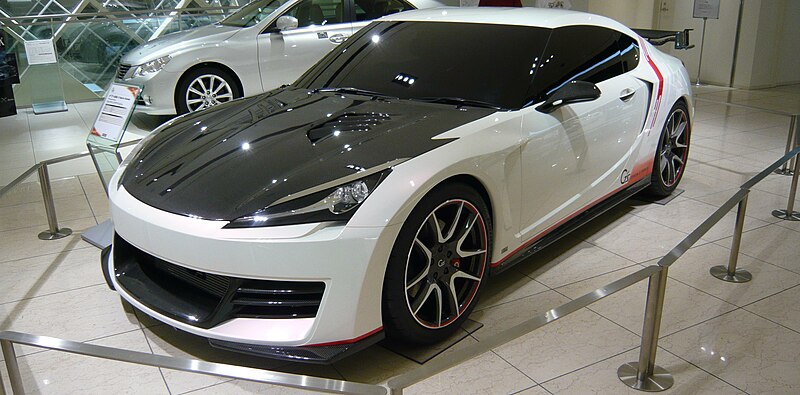

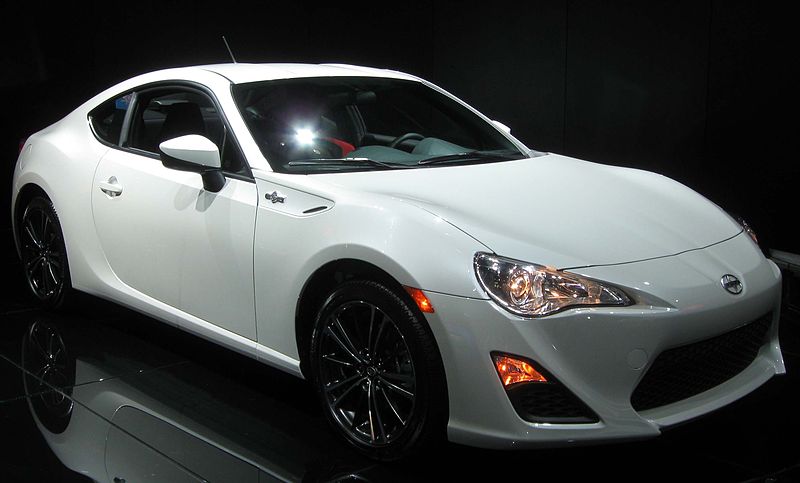
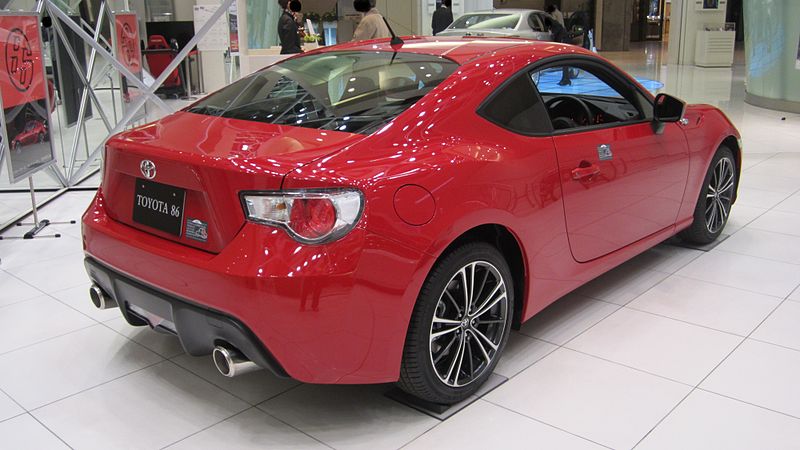 The Toyota 86 is a sports car developed jointly by Japanese automobile manufacturers Toyota and Subaru. It has 2+2 seats, a 2-door coupé body style and a front-engine, rear-wheel drive layout.
The model will be sold under three different brands: Toyota (Toyota 86 in Japan and Australia and Toyota GT-86 in Europe), Subaru (Subaru BRZ) and Scion (Scion FR-S).
"86" (pronounced "eight-six" or Hachi-Roku (ハチロク)) refers to the Toyota Corolla Levin series AE86 and the Toyota Sprinter Trueno series AE86, a particular series of cars sold between 1983 and 1987 (both the Levin and Trueno were available in coupe and hatchback bodystyles). As such, the Toyota 86 has been named as the spiritual successor of the original AE86 during the press release of the 86. The use of a boxer-style engine also refers to a historical Toyota sports car, called the Toyota Sports 800, Toyota's first sports car. Heritage of the Toyota 86 can also be traced back to the Toyota 2000GT, Toyota's second sports car with a 2.0 liter engine.
The signifigance of the reference to the series AE86 was that both the Trueno and Levin of this series were the last with rear wheel drive; the following Sprinter Trueno and Corolla Levin series AE92 were released with front wheel drive thereafter. The previous Corolla Levin and Sprinter Trueno were performance enhanced trim packages of the Corolla and Sprinter for each generation of the Levin and Trueno; the current platform is unique, and not related to the current Corolla or variants.
The Toyota and Scion have little distinguishing elements - the latter has cheaper pieces to reduce base price in the United States. The Subaru BRZ differs mainly in its front end, where the grille has an hexagonal shape versus an inverted trapezoid in the Toyota and Scion, along with the placement of the BRZ as the most luxurious variant of the platform, with more standard features and a higher suggested price than the Toyota-marketed versions.In Japan, it will be exclusive to Toyota Japan dealerships called Netz Store locations, which uses the same sales approach used at North American sales channel called Scion.
It was first presented as a concept car at the October 2009 Tokyo Motor Show under the name Toyota FT-86, FT being shorthand for "Future Toyota". Later, a high-performance version was launched at the January 2010 Tokyo Auto Salon as the Toyota FT-86 G Sports. At the 2011 Geneva Motor Show, a third concept car was shown, the Toyota FT-86 II. The BRZ and FR-S also had their concept cars, the Subaru BRZ Concept STI and the Scion FR-S Concept. The production version of the 86, BRZ and FR-S were unveiled at the 2011 Tokyo Motor Show.
Initially, the 86 and sister models will feature a Subaru-sourced naturally aspirated 2.0 L flat-4 boxer gasoline engine (Toyota engine code 4U-GSE, Subaru engine code FA20) that will deliver 200 PS (147 kW; 197 hp) that includes a direct injection system from Toyota. The model will be offered with two six-speed transmissions: a manual and an automatic with paddle shifters. The weight of the 86 is 1,180 to 1,250 kilograms (2,600 to 2,760 lb) depending on specification and equipment.
On 16th of March 2012 an line-off ceremony was held at Subaru’s Gunma Main Plant (Ota-city, Gunma Prefecture, Japan) with Toyota Motor Corporation (TMC) President Akio Toyoda and honored guests in attendance, in commemoration of the production start of the Subaru BRZ and Toyota 86. Fuji Heavy Industries (FHI) and TMC first agreed on business collaboration in October 2005. After the companies expanded their cooperative ties with new agreements related to development and production in April 2008, they then began four years of development. The completion of this joint-development product also marks a great achievement of the alliance between FHI and TMC. [3] During the first month since February 2nd 2012 Toyota received 7,000 pre-orders on Toyota 86 model in Japan
The Toyota 86 is a sports car developed jointly by Japanese automobile manufacturers Toyota and Subaru. It has 2+2 seats, a 2-door coupé body style and a front-engine, rear-wheel drive layout.
The model will be sold under three different brands: Toyota (Toyota 86 in Japan and Australia and Toyota GT-86 in Europe), Subaru (Subaru BRZ) and Scion (Scion FR-S).
"86" (pronounced "eight-six" or Hachi-Roku (ハチロク)) refers to the Toyota Corolla Levin series AE86 and the Toyota Sprinter Trueno series AE86, a particular series of cars sold between 1983 and 1987 (both the Levin and Trueno were available in coupe and hatchback bodystyles). As such, the Toyota 86 has been named as the spiritual successor of the original AE86 during the press release of the 86. The use of a boxer-style engine also refers to a historical Toyota sports car, called the Toyota Sports 800, Toyota's first sports car. Heritage of the Toyota 86 can also be traced back to the Toyota 2000GT, Toyota's second sports car with a 2.0 liter engine.
The signifigance of the reference to the series AE86 was that both the Trueno and Levin of this series were the last with rear wheel drive; the following Sprinter Trueno and Corolla Levin series AE92 were released with front wheel drive thereafter. The previous Corolla Levin and Sprinter Trueno were performance enhanced trim packages of the Corolla and Sprinter for each generation of the Levin and Trueno; the current platform is unique, and not related to the current Corolla or variants.
The Toyota and Scion have little distinguishing elements - the latter has cheaper pieces to reduce base price in the United States. The Subaru BRZ differs mainly in its front end, where the grille has an hexagonal shape versus an inverted trapezoid in the Toyota and Scion, along with the placement of the BRZ as the most luxurious variant of the platform, with more standard features and a higher suggested price than the Toyota-marketed versions.In Japan, it will be exclusive to Toyota Japan dealerships called Netz Store locations, which uses the same sales approach used at North American sales channel called Scion.
It was first presented as a concept car at the October 2009 Tokyo Motor Show under the name Toyota FT-86, FT being shorthand for "Future Toyota". Later, a high-performance version was launched at the January 2010 Tokyo Auto Salon as the Toyota FT-86 G Sports. At the 2011 Geneva Motor Show, a third concept car was shown, the Toyota FT-86 II. The BRZ and FR-S also had their concept cars, the Subaru BRZ Concept STI and the Scion FR-S Concept. The production version of the 86, BRZ and FR-S were unveiled at the 2011 Tokyo Motor Show.
Initially, the 86 and sister models will feature a Subaru-sourced naturally aspirated 2.0 L flat-4 boxer gasoline engine (Toyota engine code 4U-GSE, Subaru engine code FA20) that will deliver 200 PS (147 kW; 197 hp) that includes a direct injection system from Toyota. The model will be offered with two six-speed transmissions: a manual and an automatic with paddle shifters. The weight of the 86 is 1,180 to 1,250 kilograms (2,600 to 2,760 lb) depending on specification and equipment.
On 16th of March 2012 an line-off ceremony was held at Subaru’s Gunma Main Plant (Ota-city, Gunma Prefecture, Japan) with Toyota Motor Corporation (TMC) President Akio Toyoda and honored guests in attendance, in commemoration of the production start of the Subaru BRZ and Toyota 86. Fuji Heavy Industries (FHI) and TMC first agreed on business collaboration in October 2005. After the companies expanded their cooperative ties with new agreements related to development and production in April 2008, they then began four years of development. The completion of this joint-development product also marks a great achievement of the alliance between FHI and TMC. [3] During the first month since February 2nd 2012 Toyota received 7,000 pre-orders on Toyota 86 model in Japan


























